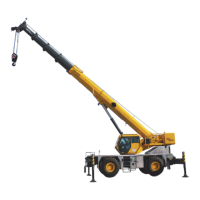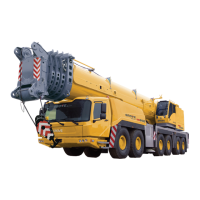OPERATING PROCEDURES GRT655/655L OPERATOR MANUAL
4-4 Published 3-23-2020, Control # 654-04
approximately 15 to 30 cm (6 to 12 in) above the level of
the opposite tire.
3. Slowly swing superstructure to left or right until axle
oscillation lock out valve is activated. This will lock rear
axle out of level. Do not swing beyond tire track.
4. After engaging swing brake, slowly drive off of block or
curb and stop. Rear tires should both be touching the
road surface and opposite front tire should be light or
slightly off road surface.
5. Release swing brake and swing superstructure until it is
centered over the front. If axle oscillation lock out valve
is functioning properly, crane will re-level itself; if valve is
not working properly, crane will not re-level itself.
If rear axle does not lock or unlock properly, do not
operate the crane until the lock out system has been
evaluated and repaired as necessary.
Accessories
Check all lights, windshield wipers, washers, washer liquid
supply, horn, instruments, signaling devices, etc.
Daily Lubrication
Make sure all components requiring daily lubrication have
been serviced. Refer to Lubrication and Maintenance,
page 6-1.
Boom
Before extending boom, make sure large access cover on
side of boom base section is installed.
Air Cleaner
Check filter restriction indicator (Tier 3 models only). Check
filter and tubing for security.
Air Intake Restriction Monitoring (AIRM)
Communications System (Tier 4 Only)
The Tier 4 engine includes the Cummins AIRM
Communications System. This calculates real-time air filter
restriction at operational flow rate using the temperature and
pressure input from the TBAP sensor, which is included on
the Direct Flow air cleaner.
When the air filter becomes dirty and should be replaced, a
maintenance fault is generated and the Engine Warning
Indicator (23, Figure 4-18 and Figure 4-19) flashes for a
period of time at every key on. Replace the air filter at the
next maintenance interval.
If the air filter continues to become more dirty, a severe
warning fault is generated and the Engine Warning Indicator
comes on (constant). A progressive engine derate will occur
to protect the engine from damage.
The generated fault codes can be viewed on the Operator
Display Module (ODM) (refer to Viewing the Engine Fault
Codes, page 4-92).
Preload Check
After crane has been readied for service, an operational
check of all crane functions (with no load applied) should be
performed. Refer to Craning Functions, page 4-24 for details
as to how to operate the different crane functions.
Preload check is as follows:
1. Extend and set outriggers and level crane.
2. Raise, lower, and swing boom right and left at least 45°.
3. Fully telescope boom out and back in at 75°, 35°, and 0°
boom angles, ensuring all sections extend and retract
properly.
4. With boom fully retracted and at maximum boom angle,
lower the hook block/overhaul ball to near ground level.
Fully extend the boom while keeping the block/ball at
near ground level.
5. With a load applied, fully retract the boom while keeping
the hook block/overhaul ball at near ground level.
Once boom is fully retracted, raise block/ball up to
boom tip.
If block/ball rotates more than 90° during this procedure,
turn dead-end becket one revolution opposite the
DANGER
Tipping Hazard!
Do not operate crane if axle oscillation lock out system is
not functioning properly.
Failure to comply with this warning may result in death or
serious injury.
CAUTION
Run engine at or near governed RPM during operation of
all crane functions.
CAUTION
Hoist Rope Damage Hazard!
Hoist rope that is not properly tensioned can cause rope
diving, which could result in rope damage.
Always properly tension the hoist rope by spooling as
much of the rope onto the hoist with as much load
available and allowable as indicated by the Load Chart.

